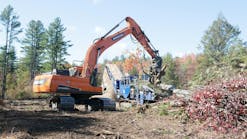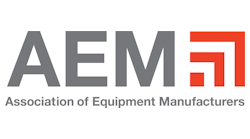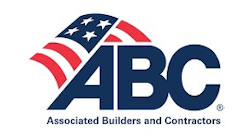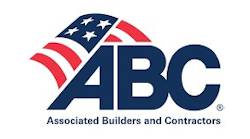“The criminal world has discovered a lucrative market: heavy construction equipment. According to the National Insurance Crime Bureau, close to $1 billion a year is lost nationwide due to the theft of construction equipment and tools.”Thus begins a report on heavy-construction-equipment theft prepared earlier this year by LoJack Corporation of Westwood, MA. Moreover, these thefts are increasing at a rapid rate. According to reports to Insurance Services Office Inc., the value of heavy-equipment thefts has been increasing by as much as 20% every year since 1996. As a result, theft now accounts for more than 50% of all causes of heavy-equipment losses.In addition to direct losses and escalating insurance-premium rates, contractors suffer substantial indirect costs, such as workforce downtime, wasted management time, and penalties for cost and schedule overruns. It all adds up to that billion-dollar annual loss.“Stealing construction equipment has been made incredibly simple by the equipment manufacturers,” says Bryan Witchey, vice president of sales and marketing for The Equipment Lock Company in Hedgesville, WV. “Each of them provides common keying in the form of a single key that fits both the cab door and the ignition of every construction vehicle they make. They do this for the convenience of their contractor customers; otherwise, if a key was mislaid, a machine could be unusable until the key was found, and it might well impede progress on the construction job during that period. However, with common keying, a thief can get a $3 key from a parts counter and with it gain access to literally millions of dollars’ worth of construction vehicles in the field.”Not only is it easy to steal construction vehicles off job sites, but nationwide, as little as 10–15% of stolen heavy equipment is ever recovered, according to Glen Sider, operations manager for National Equipment Register (NER). That compares to the national stolen-auto recovery rate of 62%, as stated in the FBI’s Uniform Crime Report for 2000. Sider explains the reasons for this wide disparity in recovery rates.“The first problem in equipment recovery is the time lapse from theft to theft discovery,” he says. “A car theft will be discovered hours, if not minutes, after the crime, whereas an equipment theft on a Friday night might not be discovered until Monday morning. Equipment owners with larger fleets or multisite operations may not discover the theft for days, weeks, or—in some cases—months. This gives the thief a window of opportunity when any investigation by law enforcement will not find a theft report. This is a particular problem because suspicious activity, such as moving equipment at a strange time of day or on ill-suited transport, is most likely to occur during this window. The gap between autos and equipment widens further when the availability of data is considered.“If a police officer stops a car in suspicious circumstances, the true owner of the vehicle can quickly be determined even if the theft has not yet been reported. This cannot be done for heavy equipment, as there is no mandated registration system for off-road equipment.“The next problem occurs when the theft is discovered. There are a number of hurdles to a ‘successful’ [heavy-] equipment loss report that do not exist for autos. Without registration or title documents, a theft victim may not have a record of the product identification number [PIN] or serial number, which is the key information needed to recover the equipment. If the owner has a PIN, it may be a shortened version, such as that on a warranty card or bill of sale, that may not be a unique identifier. As there is no standard format for the numbering of heavy equipment—a standard format has been agreed upon for earthmoving equipment but will take many years to implement—data-entry error is common and there may be confusion as to whether to file the loss as an ‘article’ or a ‘vehicle’ in national police or insurance computers.“The internationally standardized 17-character auto vehicle identification number [VIN] has an algorithm that checks the validity of the VIN; this cannot be developed for nonstandard PINs—indeed it is difficult for the officer or adjuster to even confirm that the equipment ever existed. Even when an accurate PIN is reported, there is still the risk that the owner is reporting the wrong item because, unlike most auto owners, equipment owners may have a number of similar pieces. Whatever the reason, an incorrect PIN renders the loss report almost useless.“Finally,” concludes Sider, “the lack of due diligence in the used [heavy-] equipment market is in stark contrast to that for autos. When buying a car, title documents are exchanged, and services, such as Carfax, offer full vehicle histories. Until 2002, nothing like this existed in the used-equipment market. This is a key consideration for a thief in assessing the risk of getting caught. If stolen equipment can be sold with impunity, not only does this reduce the risk of detection, but it also allows stolen equipment to be sold at, or close to, market price.”The Most Popular Equipment
Thieves certainly have their favorite targets among heavy construction fleets. According to the LoJack study, four types of equipment represent 69% of thefts, as shown in the figure. Skid-steers are stolen the most often because they are high in demand, because they are versatile and multifunctional, and because they can be readily moved from a job site onto a trailer and quickly taken to the thieves’ site. Hence, skid-steers are and probably will continue to be a popular equipment type for thieves.
Thieves certainly have their favorite targets among heavy construction fleets. According to the LoJack study, four types of equipment represent 69% of thefts, as shown in the figure. Skid-steers are stolen the most often because they are high in demand, because they are versatile and multifunctional, and because they can be readily moved from a job site onto a trailer and quickly taken to the thieves’ site. Hence, skid-steers are and probably will continue to be a popular equipment type for thieves.
Combination backhoe/front-end loaders and compressors tie for the items stolen second most often. Since combination backhoe/front-end loaders can be used for many different tasks on most job sites, they are profitable pieces of equipment to resell. In addition, since there is little visual differentiation from one backhoe to another and since they all share a common key, they are prime targets based on the ease of theft and how hard they are to track. Compressors are versatile pieces of equipment, and their high rental costs make them attractive to thieves who are looking to use them on another job or resell them at below-market rates. These pieces of equipment can be easily attached to a trailer hitch and taken from a job site.Generators are the third most often stolen. Similar to compressors, generators are versatile pieces of equipment, have high rental costs, and are easily attached to any trailer hitch. In addition, generators are useful in both the private and commercial sectors. With such a high cost of energy today, generators have become prime targets for thieves.
There are ready markets for stolen heavy equipment of all types. Thieves appear to be reselling “used” equipment to unsuspecting buyers. Moreover, there is a lucrative market for stolen construction vehicles and equipment in underdeveloped countries around the world, and once the stolen machine is across a border or aboard a ship, recovery is nearly impossible.In the main, though, the markets are local. LoJack discovered that in more than 72% of the cases studied, “the stolen equipment never left the local area. It was either in storage or in use at a local job site.” Rick Longstaff of Vista Training Inc. in Burlington, WI, tells a revealing story about this.“Some law-enforcement professionals were attending a seminar on equipment theft in the Northeast. Adjacent to the building where the seminar was in progress were a backhoe and other equipment left on a job by a local contractor. Some of the seminar attendees wanted to test their recently learned skill of locating serial numbers on mobile equipment. After class they went to the parked equipment and located the PIN.“The officers entered the PIN into the National Crime Information Center database. The machine was listed as stolen! When the officers established a stakeout of the contractor, they found that he had been stealing [pieces of] equipment from local jobs, wrapping them in plastic, and burying them on his farm until people stopped looking for the equipment. Then the contractor and an accomplice would find a willing buyer, dig up the equipment, and complete the sale. Investigators found 17 pieces of equipment buried on the thief’s farm.”The Industry Responds
With a problem of this magnitude, it was inevitable that the construction industry and its suppliers would devise ways to at least limit losses from equipment theft. Currently there are at least five different approaches:Deter the theft and increase the probability of recovery by registering the equipment.Prevent the theft by mechanical means.Track the equipment after a theft is discovered.Track the equipment at all times.Prevent the theft by electronic lockdown.Registering the Equipment
NER operates on the premise that a capable thief will be able to steal equipment however well it is protected. Hence, its service to contractors is to register the vehicles before they are stolen. The registration consists of entering a machine’s serial number, engine number, transmission number, and other selected identification numbers into an NER database, which can be accessed by law enforcement to assist in the recovery of a machine in the case of a theft. In addition, a contractor can apply an NER-provided decal to inform would-be thieves that this vehicle is registered and therefore more difficult to dispose of.“It only costs a contractor a few dollars per vehicle per year to register an entire fleet,” Sider says, “and there are six clear benefits to be gained:As soon as a theft is detected, NER can be notified and a full loss report will be added to the NER database, ensuring the speed and accuracy of the loss report.A theft may not be discovered for days, or even weeks, during which time law enforcement may have investigated the equipment with no success. NER will be able to identify the owner of registered equipment if it is found in suspicious circumstances—even before the theft has been discovered.Thieves will be deterred where equipment and premises have been marked with NER decals due to the increased likelihood of detection while moving, storing, or selling the equipment. Even if the decal is removed, the item will still be registered—and the thief knows this.Owners can record component and owner-applied numbers on NER’s HELPtech database, which not only gives law enforcement an added identification tool but also helps prove ownership.NER will be able to help law enforcement identify the true owner of any registered equipment through its 24-hour hotline used by officers investigating suspicious equipment.Theft deterrence and the increased chance of recovery will improve loss experience and will help control the cost of risk whether insured or self-insured.To illustrate the potential effectiveness of the NER service, Sider recounts a “typical” case. “A Case dealership was called out to perform maintenance and repairs on an early Case 1854C skid-steer loader. The mechanic could not find a PIN plate on the machine, and after locating the secondary number, he called Case Corporate to see if it was listed as stolen. The machine was listed with Case as stolen in 1990, but there was no further information as to whom it was stolen from or what agency took the theft report. A local sheriff’s department investigator was assigned, and being familiar with the services, he called NER for help. NER had an insurance loss record on the machine that listed the owner, date of theft, location of theft, reporting law-enforcement agency, and report number. This information allowed the officer to return this machine to the victim.“More and more law-enforcement agencies are relying on NER for information, and the 1,600 officers and agents of the National Insurance Crime Bureau have access to our databases for their theft investigations. Also, we routinely get calls from border patrols checking on suspicious vehicles. And we are urging port authorities to search our databases when they are checking vehicles due to be shipped overseas. Through registration, we are both making it difficult for thieves to dispose of stolen vehicles and increasing the chances that [the vehicles] will be returned to their owners.”Preventing Theft by Mechanical Means
The Equipment Lock Company’s approach is quite different, although it too emphasizes deterrence. The company manufactures a family of steel mechanical locking devices designed specifically for skid-steers, skid-steer attachments, backhoes, excavators, and trailer hitches. These antitheft locking devices, which list from $89.50 to $189.50 (before quantity discounts), are built with barrel-style key locks that are pick-resistant, Freon-resistant, and corrosion-resistant. Each locking device is an assembly capable of withstanding thousands of pounds of force, and each is designed to immobilize the particular vehicle when it is installed.“We actually have three different types of locking devices for skid-steer loaders,” Witchey says, “and they fit on every skid-steer loader on the market. The top-of-the-line unit immobilizes both drive controls and makes it nearly impossible to gain access to the driver’s seat. Our E-Series skid-steer locking mechanism immobilizes just one drive control, but it too renders the vehicle useless since with it in place, the thief can only drive in circles. And the skid-steer-attachment locking mechanism secures both locking arms in place so the attachment can’t be removed. If there are multiple attachments on a skid-steer, you just lower the bucket over the vehicle and lock this attachment in place so that the thief can’t get at any of the other attachments. Our backhoe lock, our excavator lock, and our ball-and-ring hitch lock are equally effective in protecting all backhoes, excavators, and trailers.”Witchey goes on to stress ancillary benefits of these mechanical antitheft devices, such as their adaptability to site safety in general and to OSHA lockout/tagout regulations designed to prevent operation of dangerous equipment in need of repair. Then he turns to homeland security. “Our products may also be used to prevent theft and utilization of equipment in areas of potential mass destruction,” he points out. “High security at airports has become imperative throughout the world. Yet unlocked airport construction, renovation, and snow-removal equipment have the potential to destroy aircraft or fuel trucks in the hands of terrorists.”
With a problem of this magnitude, it was inevitable that the construction industry and its suppliers would devise ways to at least limit losses from equipment theft. Currently there are at least five different approaches:Deter the theft and increase the probability of recovery by registering the equipment.Prevent the theft by mechanical means.Track the equipment after a theft is discovered.Track the equipment at all times.Prevent the theft by electronic lockdown.Registering the Equipment
NER operates on the premise that a capable thief will be able to steal equipment however well it is protected. Hence, its service to contractors is to register the vehicles before they are stolen. The registration consists of entering a machine’s serial number, engine number, transmission number, and other selected identification numbers into an NER database, which can be accessed by law enforcement to assist in the recovery of a machine in the case of a theft. In addition, a contractor can apply an NER-provided decal to inform would-be thieves that this vehicle is registered and therefore more difficult to dispose of.“It only costs a contractor a few dollars per vehicle per year to register an entire fleet,” Sider says, “and there are six clear benefits to be gained:As soon as a theft is detected, NER can be notified and a full loss report will be added to the NER database, ensuring the speed and accuracy of the loss report.A theft may not be discovered for days, or even weeks, during which time law enforcement may have investigated the equipment with no success. NER will be able to identify the owner of registered equipment if it is found in suspicious circumstances—even before the theft has been discovered.Thieves will be deterred where equipment and premises have been marked with NER decals due to the increased likelihood of detection while moving, storing, or selling the equipment. Even if the decal is removed, the item will still be registered—and the thief knows this.Owners can record component and owner-applied numbers on NER’s HELPtech database, which not only gives law enforcement an added identification tool but also helps prove ownership.NER will be able to help law enforcement identify the true owner of any registered equipment through its 24-hour hotline used by officers investigating suspicious equipment.Theft deterrence and the increased chance of recovery will improve loss experience and will help control the cost of risk whether insured or self-insured.To illustrate the potential effectiveness of the NER service, Sider recounts a “typical” case. “A Case dealership was called out to perform maintenance and repairs on an early Case 1854C skid-steer loader. The mechanic could not find a PIN plate on the machine, and after locating the secondary number, he called Case Corporate to see if it was listed as stolen. The machine was listed with Case as stolen in 1990, but there was no further information as to whom it was stolen from or what agency took the theft report. A local sheriff’s department investigator was assigned, and being familiar with the services, he called NER for help. NER had an insurance loss record on the machine that listed the owner, date of theft, location of theft, reporting law-enforcement agency, and report number. This information allowed the officer to return this machine to the victim.“More and more law-enforcement agencies are relying on NER for information, and the 1,600 officers and agents of the National Insurance Crime Bureau have access to our databases for their theft investigations. Also, we routinely get calls from border patrols checking on suspicious vehicles. And we are urging port authorities to search our databases when they are checking vehicles due to be shipped overseas. Through registration, we are both making it difficult for thieves to dispose of stolen vehicles and increasing the chances that [the vehicles] will be returned to their owners.”Preventing Theft by Mechanical Means
The Equipment Lock Company’s approach is quite different, although it too emphasizes deterrence. The company manufactures a family of steel mechanical locking devices designed specifically for skid-steers, skid-steer attachments, backhoes, excavators, and trailer hitches. These antitheft locking devices, which list from $89.50 to $189.50 (before quantity discounts), are built with barrel-style key locks that are pick-resistant, Freon-resistant, and corrosion-resistant. Each locking device is an assembly capable of withstanding thousands of pounds of force, and each is designed to immobilize the particular vehicle when it is installed.“We actually have three different types of locking devices for skid-steer loaders,” Witchey says, “and they fit on every skid-steer loader on the market. The top-of-the-line unit immobilizes both drive controls and makes it nearly impossible to gain access to the driver’s seat. Our E-Series skid-steer locking mechanism immobilizes just one drive control, but it too renders the vehicle useless since with it in place, the thief can only drive in circles. And the skid-steer-attachment locking mechanism secures both locking arms in place so the attachment can’t be removed. If there are multiple attachments on a skid-steer, you just lower the bucket over the vehicle and lock this attachment in place so that the thief can’t get at any of the other attachments. Our backhoe lock, our excavator lock, and our ball-and-ring hitch lock are equally effective in protecting all backhoes, excavators, and trailers.”Witchey goes on to stress ancillary benefits of these mechanical antitheft devices, such as their adaptability to site safety in general and to OSHA lockout/tagout regulations designed to prevent operation of dangerous equipment in need of repair. Then he turns to homeland security. “Our products may also be used to prevent theft and utilization of equipment in areas of potential mass destruction,” he points out. “High security at airports has become imperative throughout the world. Yet unlocked airport construction, renovation, and snow-removal equipment have the potential to destroy aircraft or fuel trucks in the hands of terrorists.”
The Skidsteer Lock antitheft deviceTracking Vehicles After a Theft
LoJack for Construction Equipment is designed specifically to get stolen off-road vehicles back to their owners. A rugged version of the original LoJack, it consists of a small, silent transmitter that is randomly hidden in a construction vehicle and runs off its power. (The company also offers a similar, battery-powered transmitter for trailers.) When the owner discovers the vehicle is missing and calls the police to report the theft, LoJack automatically becomes activated. The police can then track the vehicle’s transmitted signals and recover the vehicle. “It is the only stolen-vehicle recovery system used by the police,” claims Paul McMahon, LoJack’s director of corporate communications. The main drawback to LoJack for Construction Equipment would seem to be the fact that it does not become operative until the theft is discovered and reported to the police. Since many heavy-equipment thefts occur on weekends, thieves have a two- or three-day lead that could enable them to dispose of the vehicle before LoJack even starts to track it. It must be remembered, however, that the primary purpose of LoJack is to recover stolen vehicles; catching the thieves is secondary. Hence, this delay is disastrous only if the thieves get the stolen vehicle to a fast-moving chop shop or across a national border. It is perhaps not coincidental that LoJack found that 50% of the thefts it studied occurred in the border states of California, Arizona, and Texas, and another 27% occurred in the state of Florida.Even so, the system has had considerable success, perhaps justifying its one-time cost of $695 (before fleet discounts). According to the LoJack study on construction equipment theft, “During the twelve-month period from January through December 2002, LoJack tracked recovery reports in seventeen states where equipment theft was reported and where construction equipment outfitted with LoJack led police to recover the stolen goods. In those seventeen states, police reported that after [they tracked] stolen equipment with a LoJack device, seven theft rings were disbanded with an approximate value of over $4,000,000 of additional equipment recovered. Three chop shops were also uncovered with an approximate value of $3,000,000.”Perhaps of more immediate interest to LoJack users was the reduced damage rate. The study adds, “Some 87% of the LoJack-equipped construction equipment was recovered in less than twenty-four hours after being reported to the police, and 29% was recovered in less than sixty minutes. This quick recovery has resulted in a minimal damage rate. 95% of the equipment stolen and recovered with LoJack was undamaged. This is much lower than in the car industry, where 80% of the cars stolen are damaged.”Tracking Fleet Vehicles ContinuouslyWith the ready availability of global positioning system (GPS) satellite tracking for fleet management and maintenance (see “Bringing Fleet Management to the Construction Industry” in the January/February 2003 issue of Grading & Excavation Contractor or view it on-line at www.forester.net/gx_0301_bringing.html), there are already a number of systems with a built-in capability for theft detection and tracking. John Marshall, director of sales and customer support for Chase Construction NA in Racine, WI, also emphasizes that Case’s FleetLink GPS-based system was not created for theft deterrence. “[It’s meant] to provide customers a mechanism for measuring the productivity of their machines, for maximizing return on assets, and for maximizing the efficiency of their operations. FleetLink uses GPS satellites, cellular-phone technology, and the Internet to provide owners with each machine’s geographic position, hour-meter reading, and vehicle battery voltage. Owners can then access this up-to-date information via a password-protected FleetLink Web site.”He adds, however, that Case has been investigating all aspects of theft deterrence, from machine tracking to key passwords. In fact, Case—in collaboration with Vista Training, CNA Insurance Company, and the National Utility Contractors Association—has developed a 20-min. video with training support materials focused on theft avoidance.And clearly Case regards FleetLink’s theft-avoidance and recovery capability as a handy, important asset in addition to its “primary” fleet-management and maintenance capabilities. “Let’s face it,” Marshall says, “the ability to shorten the time between the theft of a Case machine and the recognition that a theft has occurred greatly increases a contractor’s chance of recovering that machine. And FleetLink recognizes when one of our machines moves, and it alerts our data center so that we can promptly contact the owner and initiate a recovery effort. FleetLink only costs a contractor $15 per vehicle per month for both hardware and service, yet it enables authorities to track the whereabouts of any vehicle from signals sent from the built-in cell phone.“It can be effective too. Recently our service center received an alert that one of a Florida contractor’s skid-steers was on the move at four o’clock on a Sunday morning. It seemed unlikely that one of our customer’s drivers was using the machine at that hour, so we notified the owner and he called local enforcement, providing the system-generated current location of the vehicle and the direction it was heading. The police intercepted the vehicle just as it was reaching a chop shop.”Thus, while Case calls its FleetLink system an asset management tool, contractors who install the system have built-in theft protection that certainly can add to its value.Other manufacturers, such as Alan Day, president of HeavyTrack.com Inc. of San Antonio, TX, do market the antitheft capability of their GPS-based methods but present it as a valuable adjunct of their fleet-management capabilities. To quote the HeavyTrack.com Web site, “The HeavyTrack System is the heavy-equipment leader for value and features. The time and money savings for each HeavyTrack system pays for [the system] many times over through reduced number of trips for personnel/trucks, increased utilization of fleet/personnel, lower insurance rates, recovered stolen equipment, increased work time, unused insurance deductible, and rental overuse.”Elsewhere on the Web site and in our interview, though, Day makes it clear that the HeavyTrack system is quite effective in theft recovery, stating that HeavyTrack systems in the field led to the recovery of 45 machines worth more than $2 million in one 22-month period. The system has a geofence capability that generates an alert if a vehicle leaves a permitted area or enters a prohibited area, such as a port or a border. The system can also define a secure period (usually at night) and generate an alert if a vehicle moves or is moved more than a short distance during that period.“We charge $695 for the hardware, which includes the GPS receiver and Microburst phone, a covert GPS/cellular antenna, a backup battery, and the wiring harness,” Day says. “And we charge a monthly fee for the use of our response center where we can track every vehicle. The service fee for the complete system, which includes instant-location services, fleet-usage monitoring, and employee accountability, as well as security and theft-recovery services, is $199 per year. If a customer is using lesser system capabilities, the service fee comes down to just $69 a year. And, of course, we offer liberal fleet discounts.”HeavyTrack had quite a busy Fourth of July in 2003, when police recovered four stolen backhoes belonging to four different contractors on that one day. “One of these backhoes had our system on it,” Day recalls. “Using our tracking data, the police found this backhoe plus two others in a warehouse in Laredo [Texas] where they were waiting to be taken across the border into Mexico. All the owners were happy, of course, but one of them was a little embarrassed. He was one of our customers, but he hadn’t had time to install the system on his new backhoe before it was stolen.“The fourth backhoe recovery occurred when the system located the vehicle on [Interstate 75] in Kentucky, heading for Cincinnati. The Cincinnati police were alerted and were provided with a continuous report of the vehicle’s position and heading. With that data, it was easy for them to intercept the backhoe and subsequently return it to its owner. And the thieves were caught red-handed. That’s another advantage of a system like ours. Over 500 individuals have been apprehended while trying to steal vehicles with GPS/cellular tracking devices installed. Courts have also used the data from GPS/cellular tracking devices as evidence to convict the thieves and put them behind bars.”Prevent Theft by Electronic Lockdown
Another inherent capability of a GPS-based system is the use of software to electronically disable vehicles so they cannot be illicitly moved. Phil Welliver, director of dealer and sales support for GPS Management of Brownsburg, IN, says his company’s MB3000 HEU system, list-priced at $350–$500 plus $5–$25 per month per vehicle, can do just that.
LoJack for Construction Equipment is designed specifically to get stolen off-road vehicles back to their owners. A rugged version of the original LoJack, it consists of a small, silent transmitter that is randomly hidden in a construction vehicle and runs off its power. (The company also offers a similar, battery-powered transmitter for trailers.) When the owner discovers the vehicle is missing and calls the police to report the theft, LoJack automatically becomes activated. The police can then track the vehicle’s transmitted signals and recover the vehicle. “It is the only stolen-vehicle recovery system used by the police,” claims Paul McMahon, LoJack’s director of corporate communications. The main drawback to LoJack for Construction Equipment would seem to be the fact that it does not become operative until the theft is discovered and reported to the police. Since many heavy-equipment thefts occur on weekends, thieves have a two- or three-day lead that could enable them to dispose of the vehicle before LoJack even starts to track it. It must be remembered, however, that the primary purpose of LoJack is to recover stolen vehicles; catching the thieves is secondary. Hence, this delay is disastrous only if the thieves get the stolen vehicle to a fast-moving chop shop or across a national border. It is perhaps not coincidental that LoJack found that 50% of the thefts it studied occurred in the border states of California, Arizona, and Texas, and another 27% occurred in the state of Florida.Even so, the system has had considerable success, perhaps justifying its one-time cost of $695 (before fleet discounts). According to the LoJack study on construction equipment theft, “During the twelve-month period from January through December 2002, LoJack tracked recovery reports in seventeen states where equipment theft was reported and where construction equipment outfitted with LoJack led police to recover the stolen goods. In those seventeen states, police reported that after [they tracked] stolen equipment with a LoJack device, seven theft rings were disbanded with an approximate value of over $4,000,000 of additional equipment recovered. Three chop shops were also uncovered with an approximate value of $3,000,000.”Perhaps of more immediate interest to LoJack users was the reduced damage rate. The study adds, “Some 87% of the LoJack-equipped construction equipment was recovered in less than twenty-four hours after being reported to the police, and 29% was recovered in less than sixty minutes. This quick recovery has resulted in a minimal damage rate. 95% of the equipment stolen and recovered with LoJack was undamaged. This is much lower than in the car industry, where 80% of the cars stolen are damaged.”Tracking Fleet Vehicles ContinuouslyWith the ready availability of global positioning system (GPS) satellite tracking for fleet management and maintenance (see “Bringing Fleet Management to the Construction Industry” in the January/February 2003 issue of Grading & Excavation Contractor or view it on-line at www.forester.net/gx_0301_bringing.html), there are already a number of systems with a built-in capability for theft detection and tracking. John Marshall, director of sales and customer support for Chase Construction NA in Racine, WI, also emphasizes that Case’s FleetLink GPS-based system was not created for theft deterrence. “[It’s meant] to provide customers a mechanism for measuring the productivity of their machines, for maximizing return on assets, and for maximizing the efficiency of their operations. FleetLink uses GPS satellites, cellular-phone technology, and the Internet to provide owners with each machine’s geographic position, hour-meter reading, and vehicle battery voltage. Owners can then access this up-to-date information via a password-protected FleetLink Web site.”He adds, however, that Case has been investigating all aspects of theft deterrence, from machine tracking to key passwords. In fact, Case—in collaboration with Vista Training, CNA Insurance Company, and the National Utility Contractors Association—has developed a 20-min. video with training support materials focused on theft avoidance.And clearly Case regards FleetLink’s theft-avoidance and recovery capability as a handy, important asset in addition to its “primary” fleet-management and maintenance capabilities. “Let’s face it,” Marshall says, “the ability to shorten the time between the theft of a Case machine and the recognition that a theft has occurred greatly increases a contractor’s chance of recovering that machine. And FleetLink recognizes when one of our machines moves, and it alerts our data center so that we can promptly contact the owner and initiate a recovery effort. FleetLink only costs a contractor $15 per vehicle per month for both hardware and service, yet it enables authorities to track the whereabouts of any vehicle from signals sent from the built-in cell phone.“It can be effective too. Recently our service center received an alert that one of a Florida contractor’s skid-steers was on the move at four o’clock on a Sunday morning. It seemed unlikely that one of our customer’s drivers was using the machine at that hour, so we notified the owner and he called local enforcement, providing the system-generated current location of the vehicle and the direction it was heading. The police intercepted the vehicle just as it was reaching a chop shop.”Thus, while Case calls its FleetLink system an asset management tool, contractors who install the system have built-in theft protection that certainly can add to its value.Other manufacturers, such as Alan Day, president of HeavyTrack.com Inc. of San Antonio, TX, do market the antitheft capability of their GPS-based methods but present it as a valuable adjunct of their fleet-management capabilities. To quote the HeavyTrack.com Web site, “The HeavyTrack System is the heavy-equipment leader for value and features. The time and money savings for each HeavyTrack system pays for [the system] many times over through reduced number of trips for personnel/trucks, increased utilization of fleet/personnel, lower insurance rates, recovered stolen equipment, increased work time, unused insurance deductible, and rental overuse.”Elsewhere on the Web site and in our interview, though, Day makes it clear that the HeavyTrack system is quite effective in theft recovery, stating that HeavyTrack systems in the field led to the recovery of 45 machines worth more than $2 million in one 22-month period. The system has a geofence capability that generates an alert if a vehicle leaves a permitted area or enters a prohibited area, such as a port or a border. The system can also define a secure period (usually at night) and generate an alert if a vehicle moves or is moved more than a short distance during that period.“We charge $695 for the hardware, which includes the GPS receiver and Microburst phone, a covert GPS/cellular antenna, a backup battery, and the wiring harness,” Day says. “And we charge a monthly fee for the use of our response center where we can track every vehicle. The service fee for the complete system, which includes instant-location services, fleet-usage monitoring, and employee accountability, as well as security and theft-recovery services, is $199 per year. If a customer is using lesser system capabilities, the service fee comes down to just $69 a year. And, of course, we offer liberal fleet discounts.”HeavyTrack had quite a busy Fourth of July in 2003, when police recovered four stolen backhoes belonging to four different contractors on that one day. “One of these backhoes had our system on it,” Day recalls. “Using our tracking data, the police found this backhoe plus two others in a warehouse in Laredo [Texas] where they were waiting to be taken across the border into Mexico. All the owners were happy, of course, but one of them was a little embarrassed. He was one of our customers, but he hadn’t had time to install the system on his new backhoe before it was stolen.“The fourth backhoe recovery occurred when the system located the vehicle on [Interstate 75] in Kentucky, heading for Cincinnati. The Cincinnati police were alerted and were provided with a continuous report of the vehicle’s position and heading. With that data, it was easy for them to intercept the backhoe and subsequently return it to its owner. And the thieves were caught red-handed. That’s another advantage of a system like ours. Over 500 individuals have been apprehended while trying to steal vehicles with GPS/cellular tracking devices installed. Courts have also used the data from GPS/cellular tracking devices as evidence to convict the thieves and put them behind bars.”Prevent Theft by Electronic Lockdown
Another inherent capability of a GPS-based system is the use of software to electronically disable vehicles so they cannot be illicitly moved. Phil Welliver, director of dealer and sales support for GPS Management of Brownsburg, IN, says his company’s MB3000 HEU system, list-priced at $350–$500 plus $5–$25 per month per vehicle, can do just that.
After receiving a theft alarm, this contractor remotely tracks his backhoe via the Titan Anti-Theft System“The HEU is a heavy-equipment unit that tracks the location, heading, and speed of any piece of heavy equipment,” Welliver says. “The unit is housed in a NEMA-compliant casing and comes with a backup battery. With it, you can remotely disable or enable equipment ignition, monitor vehicle condition, and have an alarm sent to you if the equipment moves outside of predetermined boundaries. In case of emergency, you can use the frequent-track mode to locate and recover your equipment quickly.“The vehicle must be stationary before it can be electronically disabled, but the next time the thief attempts to turn the engine on, he won’t be able to. And if he gets out of the cab to investigate, he’ll find that the doors have been electronically locked. That would probably end the threat right there, at a stop sign on a city street. These features are most likely to be used in conjunction with the system’s geofence capability. It can be established that if a vehicle moves out of a job-site area and/or into a prohibited area, an alert will be generated, and the contractor can turn on the system’s continuous report function and follow the vehicle’s movement on a street-map display. If the thief stops, the vehicle can be disabled; if he keeps moving, the police can intercept him based on the location and direction information provided by the system.”DPL America’s Titan system takes this concept one step further. It creates an electronic curfew. Tony Nicoletti, director of sales for the Mountain View, CA–based firm, explains. “Hidden on heavy construction equipment vehicles, which can be of any make or model, the Titan receivers can receive signals that cause them to automatically disable the vehicles on any or all job sites every night so that they cannot be started until the crews arrive the next day. Even hot-wiring and universal keys are useless. And the best part for many contractors is that this capability doesn’t require any special programming, special keys, or manual locks. Titan also monitors a handful of different conditions on the vehicles after nightfall. This results in an immediate call to the contractor if any tampering occurs. And, of course, GPS tracking is included to locate any Titan-equipped vehicle during daylight hours. A simple click plots the location and direction of any vehicle on a street-map display.”Titan is actually a version of DPL America’s Asset Manager, a GPS-based fleet management system. Last year, however, DPL America did some market research with contractors and concluded that while contractors regard fleet management and maintenance capabilities as a worthwhile convenience, the rise in thefts and the resultant costs concern them much more. So DPL America added fleet lockdown and other antitheft software and began marketing the system as the “Titan Anti-Theft System: Never lose another machine.”“We just released the Titan this June,” Nicoletti says. “We priced it at $595 list plus $4.50 a month, and the response has been fantastic. Of course, contractors understand that they can also use the Titan for fleet management or maintenance, but what really excites them about the Titan is its antitheft capabilities. They are what will sell the system.”And perhaps it will introduce some of them to the advantages of automated fleet management. In the long run, probably, contractors who buy GPS-based devices will use them for theft protection as well as for other built-in functions they find useful. And other contractors will register their vehicles, buy mechanical locking systems, sign up with LoJack, or adopt a combination of these partial solutions as needed for their particular situations.








